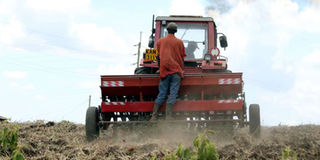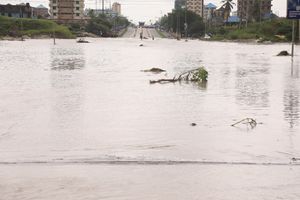EA growth forecast to remain buoyant

A tractor tills a farm in readiness of the planting season at nairutia in nyeri county. JOSEPH KANYI | NMG
What you need to know:
East Africa remains the fastest-growing sub region in Africa, with estimated growth of 5.6 per cent in 2017, up from 4.9 per cent in 2016.
Nairobi. Resurgence in agriculture, infrastructure and manufacturing is expected to lift East Africa’s economic performance in 2018, an outlook by the African Development Bank (AfDB) shows.
East Africa remains the fastest-growing sub region in Africa, with estimated growth of 5.6 per cent in 2017, up from 4.9 per cent in 2016.
Growth is expected to remain buoyant, reaching 5.9 per cent in 2018 and firming further to 6.1 per cent in 2019.
“Strong growth is widespread in the sub region, with many countries including Djibouti, Ethiopia, Kenya, Rwanda, Tanzania and Uganda growing five per cent or more” the bank says in its Africa Economic Outlook 2018. Agriculture will rebound after poor harvests last year on improved rainfall, the bank said noting that inflation spiked to nearly 10 per cent in the region, fuelled by a rise in food prices especially in Kenya, where the effects of the early 2017 drought reduced the maize harvest, causing chronic shortages of the staple.
Median inflation
“Median inflation is projected to fall sharply in East Africa, partly as a result of an improved harvest” the report notes. Consumerism and mega infrastructure projects are also expected to bolster growth this year. “Private consumption is the most important driver of growth in Comoros and Kenya while public investment in infrastructure has been instrumental in Djibouti and Ethiopia. Construction will remain strong. In a few countries, continued expansion of services, including information and communications technology, will be key,” the report says.
“Manufacturing may increase the share of industry, particularly in Kenya and Tanzania,” it adds.
There are, however, numerous factors that could threaten the region’s growth.
In Kenya, for example, the uncertainty following the prolonged electioneering period is expected to continue hanging over the economy stifling private-sector activity. The interest rate caps also remain a concern amid reported constraints in credit expansion, leading to reduced private sector investment.
Public consumption
“Continued high public consumption expenditure keeps the budget deficit at close to 10 per cent of gross domestic product (GDP), while the expected maturity of public debt could lead to debt distress” AfDB says.
In Tanzania, uncertainty in the business environment following changes in policies, regulations, and tax administration could weigh on private sentiment and slow growth and investment, particularly in the mining sector.
Tanzania economic outlook
• Growth is projected to remain robust at 6.7 per cent in 2018 and 6.9 per cent 2019, representing one of the best performances in East Africa
• Construction, mining, transport, and communications were key growth drivers in 2017.
• Growth in the first two quarters of 2017 averaged 6.8 per cent and was estimated at 6.5 per cent for the full year.




